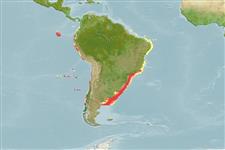Teleostei (teleosts) >
Pleuronectiformes (Flatfishes) >
Paralichthyidae (Large-tooth flounders)
Etymology: Paralichthys: Greek, para = the side of + Greek, ichthys = fish + Greek, suffix, oides = similar to (Ref. 45335).
More on author: Jordan.
Environment: milieu / climate zone / depth range / distribution range
Ecology
Marine; demersal; depth range 6 - 200 m (Ref. 36453), usually 70 - 100 m (Ref. 43588). Subtropical; - 43°S
Southeast Pacific: Chile (Ref. 9068). Southwest Atlantic: Rio de Janeiro, Brazil to Patagonia, Argentina (Ref. 36453).
Length at first maturity / Size / Weight / Age
Maturity: Lm 33.5 range ? - ? cm
Max length : 48.0 cm TL male/unsexed; (Ref. 43588); 62.0 cm TL (female); common length : 40.0 cm TL male/unsexed; (Ref. 6077)
Ranges from the coast to 200 m depth (Ref. 36453). Frequently captured over sandy bottoms (Ref. 42588). Feeds mainly on fishes, also shrimps (Ref. 36453).
Life cycle and mating behavior
Maturities | Reproduction | Spawnings | Egg(s) | Fecundities | Larvae
Distinct pairing (Ref. 205).
Figueiredo, J.L. and N.A. Menezes, 2000. Manual de peixes marinhos do sudeste do Brasil. VI.Teleostei (5). Museu de Zoologia, Universidade de São Paulo. Brazil. 116 p. (Ref. 36453)
IUCN Red List Status (Ref. 130435)
Threat to humans
Harmless
Human uses
Fisheries: commercial
Tools
Special reports
Download XML
Internet sources
Estimates based on models
Preferred temperature (Ref.
123201): 4.8 - 19.9, mean 10.1 °C (based on 74 cells).
Phylogenetic diversity index (Ref.
82804): PD
50 = 0.5000 [Uniqueness, from 0.5 = low to 2.0 = high].
Bayesian length-weight: a=0.00537 (0.00452 - 0.00638), b=3.16 (3.11 - 3.21), in cm total length, based on LWR estimates for this species (Ref.
93245).
Trophic level (Ref.
69278): 3.9 ±0.66 se; based on food items.
Resilience (Ref.
120179): Medium, minimum population doubling time 1.4 - 4.4 years (K=0.3).
Fishing Vulnerability (Ref.
59153): Moderate to high vulnerability (51 of 100).
Nutrients (Ref.
124155): Calcium = 71.3 [31.6, 128.5] mg/100g; Iron = 0.966 [0.464, 1.748] mg/100g; Protein = 16.1 [13.8, 19.5] %; Omega3 = 0.208 [0.110, 0.380] g/100g; Selenium = 31.6 [14.3, 71.3] μg/100g; VitaminA = 14.1 [3.5, 55.7] μg/100g; Zinc = 0.526 [0.349, 0.788] mg/100g (wet weight); based on
nutrient studies.
